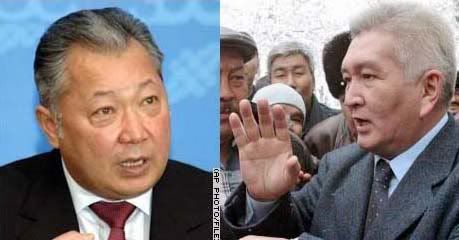Kulov Leads the Opposition towards the 2nd Anniversary of the “Revolution”: Will St. Patrick’s Day Bring More Tulips or the beginnings of Civil War?

Having weathered several political crises since being elected to office in July 2005, President Kurmanbek Bakiyev may soon face his biggest challenge from his former Prime Minister, Felix Kulov.
Despite moving into the Bishkek White House in 2005 backed by popular sentiment calling for an end to corruption and the adoption of political reforms, President Bakiyev has yet to initiate any of the lasting reforms he had promised. In this context, last November, protests organized by opposition politicians and civil society leaders sought to hold President Bakiyev accountable for the numerous reforms he had promised to undertake. When Bakiyev did not cave-in to most of the protesters’ demands, the protests became more radical and threatened to tear apart his tenuous hold on power.
At that time, the opposition had hoped that Prime Minister Felix Kulov might “jump ship” and lead the opposition movement in an ouster of the Bakiyev regime. Instead, however, Kulov remained loyal to his political partner and was complicit in attempts to weaken the position of the protesters. As a result, the parliament refused to approve Kulov’s re-appointment as Prime Minister under the new constitution that the November protests had initiated. Finding himself on the outside of government again, Kulov recently moved himself back into the opposition camp.
Despite the fact that many in the opposition feel betrayed by him and subsequently voted against his continuance as prime minister, Kulov has quickly become a personality around which a rejuvenated opposition to Bakiyev’s regime has consolidated. With the second anniversary of the “Tulip Revolution” being celebrated on March 24 of this year, it is assumed by many that Kulov will be a driving force behind new protests against Bakiyev’s government. Sources in Bishkek say that Kulov is already working with other opposition politicians to organize a large protest on March 17 (St. Patrick’s Day), a week prior to the “revolution’s” second birthday. One of the demands of the protest will be to force Bakiyev to resign and call for new presidential elections.
It is unclear how such protests, if they do take place, will play out. While it is unlikely that Bakiyev will voluntarily step down, he may once again successfully retain his power by making various concessions (even if they are not actually implemented). Likewise, it is not outside the realm of possibility that the protests could result in a repeat of the regime change that ousted Askar Akayev two years earlier. Some in Kyrgyzstan, however, suggest that renewed protests led by Kulov could also become violent and lead to a destabilizing conflict between the north and south of the country.
The reason for these fears is that for the last two years, Bakiyev and Kulov have come to represent the “south” and “north” of Kyrgyzstan respectively in the popular imagination of the country. When they formed a ruling tandem within the government, this regional representation was seen as a mechanism to maintain balance between the two major regions of the country. Furthermore, the conflict between Bakiyev and the opposition was also not seen previously as being a north-south conflict since Tekebayev, who is also from the south, was portrayed as the leader of the opposition. With Kulov apparently taking over that role, however, many in Kyrgyzstan will begin to view the political competition between Kulov and Bakiyev as essentially a battle for political and economic influence between the north and the south. And, if this does in fact happen, there are many who suggest that street protest politics could easily become street warfare, and the violence could rival that of the Osh riots of 1990.
Those who have optimistic wishes for Kyrgyzstan’s fragile experiments in democracy, of course, hope this is not where the political arena is headed. Nonetheless, Kyrgyzstan-watchers should mark March 17 on their calendars for more than St. Patrick’s Day celebrations.



1 Comments:
A couple of quick points:
1) I think the opposition had been seen as northern by many southerners even when Tekebaev was "in charge" - he has roots in Talas. If you look at the presumed funding sources of the opposition, you don't see a lot of rich Kyrgyz southerners involved
2) There have been a number of times in the past couple of years when civil war seemed inevitable - there seems to be something about Kyrgyzstani people that manages to pull away from violent conflict just before the logic of violence spiralling out of control kicks in - let's hope that continues
Post a Comment
<< Home